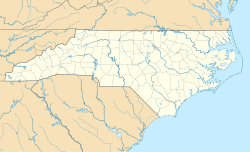Rock Cliff Farm | |
| Location | western end of Bent Rd., near Wake Forest, North Carolina |
|---|---|
| Coordinates | 35°59′59″N78°38′47″W / 35.99972°N 78.64639°W |
| Area | 83.4 acres (33.8 ha) |
| Built | 1950 |
| Built by | Wells, Bertram Whittier |
| Architectural style | Triple-A house |
| NRHP reference No. | 07000879 [1] |
| Added to NRHP | August 29, 2007 |
Rock Cliff Farm, also known as the B.W. Wells Farm, is a historic farm and national historic district located near Wake Forest, Wake County, North Carolina. The property is owned by the Federal government, and part of a large acreage managed by the State of North Carolina as the Falls Lake State Recreation Area. Contributing resources include the Grounds of Rock Cliff Farm, Ray-Wells House (c. 1895, c. 1954), meathouse (c. 1885-1890), Lowery-Ray Cemetery (1901), studio (1954, c. 1955-1960), lumber storage rack (c. 1954-1955), Ray House (c. 1900-1920), and Ray House Outbuilding (c. 1900-1920). Rock Cliff Farm was the retirement residence of Dr. Bertram Whittier Wells (1884-1978), a noted American botanist and ecologist active. [2]
The district was listed on the National Register of Historic Places in 2007. [1]

